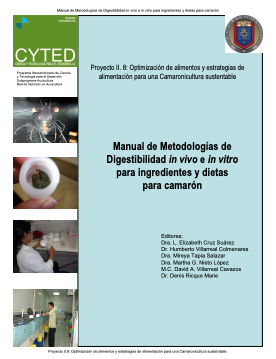“Floc” Contribution to Peneid Intensive Culture
Palabras clave:
bacteria, nitrification, phytoplankton, intensive culture, shrimp.Resumen
The bacterial “floc” is a very complex ecosystem that works in a multifactor context where each parameter needs to
be considered. The bacterial microflora played initially the major role; it could stand on a unique role in total
darkness. However, outdoors tanks getting larger and larger dimension induced an additional factor with the presence
of phytoplankton. At start, a few programs were held in order to comprehend how such a “black box” would
function, some people speaking of an “external rumen”. Implication are coming from different fields such as the
evolution of each bacteria communities in the medium, feed composition, management of wastes, sizing for a
commercial operation. How shrimp performed in such environment? How shrimp could derive so many nutrients for
its growth; would such a culture system be explained through a model? .
First very positive results came from a zootechnical approach with considerable improvement in weight gain, healthy
animals at harvest compared to regular earthen ponds production; and recently it was evidenced a potential for
reproduction of Litopenaeus stylirostris.
That is the purpose of this paper to present a comprehensive approach of the use of “floc” ecosystem in a tank
structure called also “moulinettes”. Today there is such a great attention from farmers willing to go into intensive or
super-intensive culture system that a comprehension of the trophic chain is necessary. Finally, there are great
expectations for a biosecurity aspect with the disappearance of diseases outbreaks, the possibility to develop culture
out of the constraints of the seashore and overall an application of the concept of sustainability linked with a
profitable operation.
Descargas
Citas
Aminot A et Chaussepied M., 1983. Manuel des analyses chimiques en milieu marin. CNEXO, 395pp.
Aquacop, 1984. Aquaculture en milieu tropical. Ifremer publications, Brest, France, 47pp.
Aquacop et Garen, P.1992. Elevage intensif de crevettes peneides. Le point des techniques au COP. Rapport interne
COP, DRV/AQ/TAH 92.018, 18pp.
Avnimelech Y., Kochva M. and Diab S. 1994. Development of controlled intensive aquaculture systems with a
limited water exchange and adjusted carbon to nitrogen ratio. The Israeli Journal of Aquaculture, 46:119-
Avnimelech, Y. 1999. Carbon/nitrogen ratio as a control element in aquaculture systems. Aquaculture. 176 (3-4)
-235.
Bianchi M. and Bianchi A, 1982. Evolution a court terme des effectifs et de l’activite des communautes bacteriennes
dans les ecosystems d’aqauculture. 2eme Colloque Microbiologie Marine, Marseille, 1981. CNEXO ed.
Actes colloques, 13:61-70.
Funge Smith SJ. and Briggs, MRP. 1998. Aquaculture, 164: 117-133.
Jousselin Y., Garen, P. y Aquacop, 1993. Engorde intensivo del camarón: el rigor del manejo permite doblar la
producción. II Congreso Ecuatoriano de Acuicultura, Guayaquil, Ecuador, 20-25 Octubre.
Racotta IS., Palacios E. and Ibarra AM. 2003. Shrimp larval quality in relation to broodstock condition. Aquaculture,
: 107-130.
Samocha, TM; Patnaik, S; Speed, M; Ali, A-M; Burger, JM; Almeida, RV; Ayub, Z; Harisanto, M; Horowitz, A;
Brock, DL2007. Use of molasses as carbon source in limited discharge nursery and grow-out systems for
Litopenaeus vannamei. Aquacult. Eng. 36(2)184-191.
Sohier, L. 1983. Participation des micro-organismes marins au maintien des capacites de production des milieux
eutrophes a faible taus de renouvellement utilizes pour l’elevage intensif de crevettes peneides. These Univ.
Aix-Marseille II,134pp.
Wasielesky, W., Atwood, H., Stokes, A., Browdy, CL. 2006. Effect of natural production in a zero exchange
suspended microbial floc based super-intensive culture system for white shrimp Litopenaeus vannamei.
Aquaculture. 258(1-4) 396-403.





